To setup a DMR repeater with MMDVM, often the transceiver used are Motorola. This time, I sought to implement TAIT® branded transceivers also used by professionals. The TM8100 series (TM8105, TM8110, TM8115…) works with MMDVM in both ways, in reception and transmission.
Thanks to this tutorial, you are invited to realize the settings of your Tait® transceivers. In my case, I use TM8110 UHF 10 channels. Let’s see this in a few steps.
Connection
First of all the rear socket of the station is a female DB15 socket. We will exploit these 5 pins which will be connected on the filtering MMDVM shield (Arduino Due ou STM32):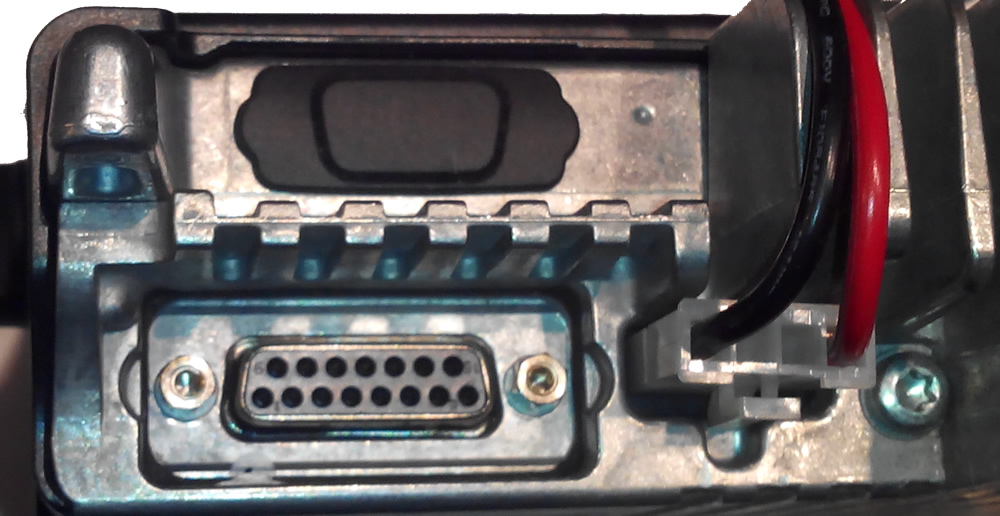
- 6 RSSI (optionnal for RX way)
- 7 Audio Input (TX way)
- 12 PTT* (TX way)
- 13 Audio Output (RX way)
- 15 Ground
The PTT pin will be configured as alternate output with the Tait programming application.
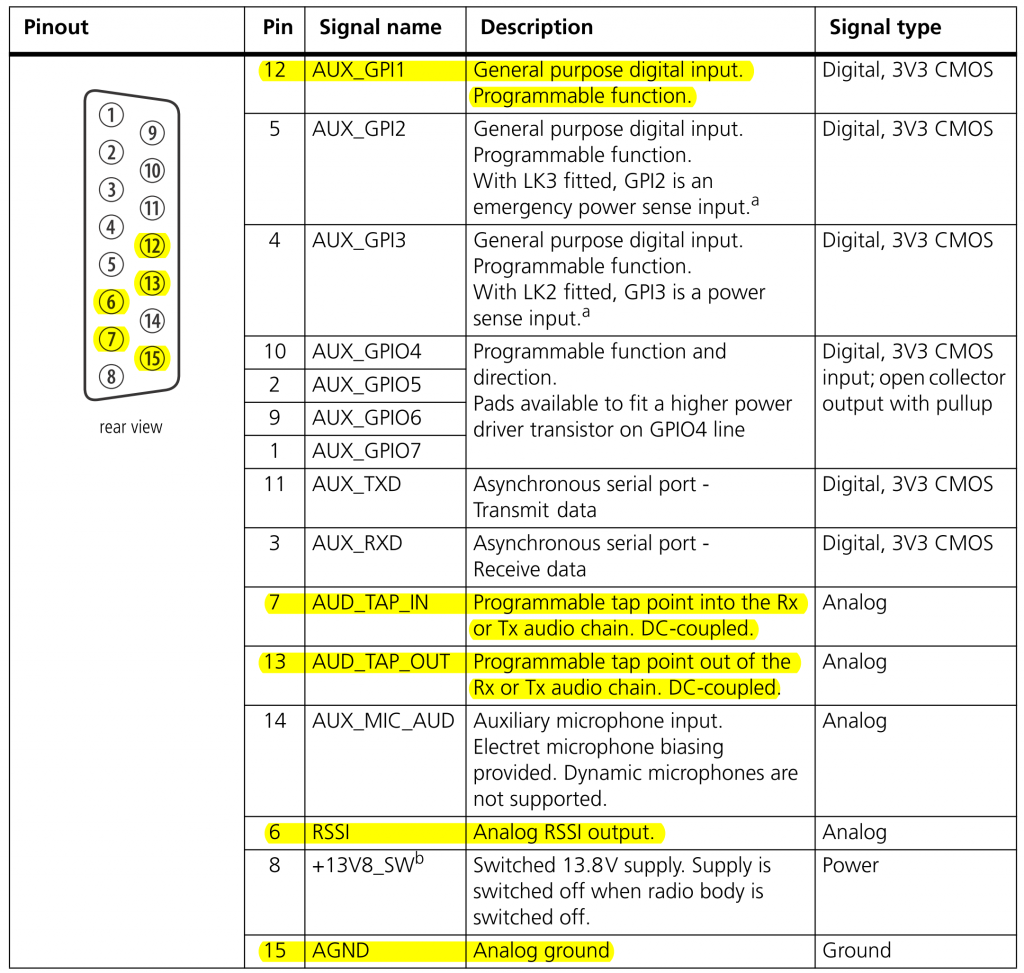
TAIT TM8100 rear connector
Tait® Transceiver Settings
The configuration of the two transceivers (transmitter and receiver of the MMDVM repeater) can be the same programming.
Receiving/transmining channel
Using the Tait® programming application, we define a channel corresponding to the frequencies of the repeater (Channel Configuration menu). The receive bandwidth must be set to 12.5 (advised by Adrian) or 20 kHz.
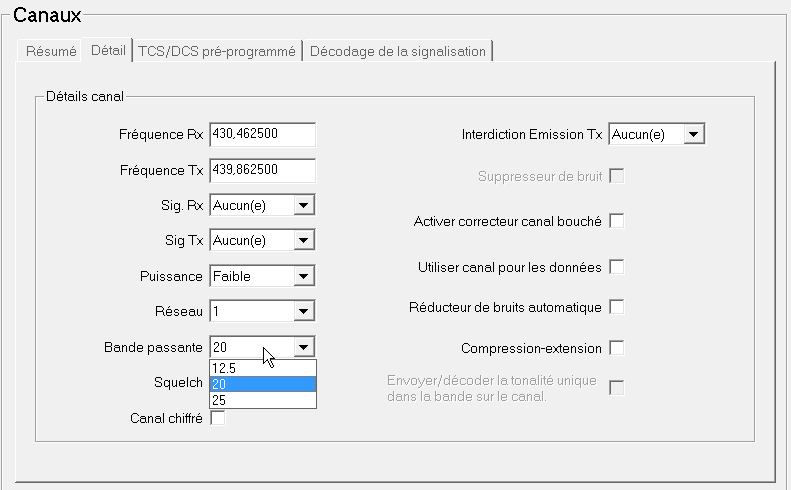
Inputs and outputs programming
In order for the pin 12 assigned to the PTT to be configured, we program in the Tait® software (programmable I/O part) that the AUX_GPI1 pin is an input channel with an external alternate 1.
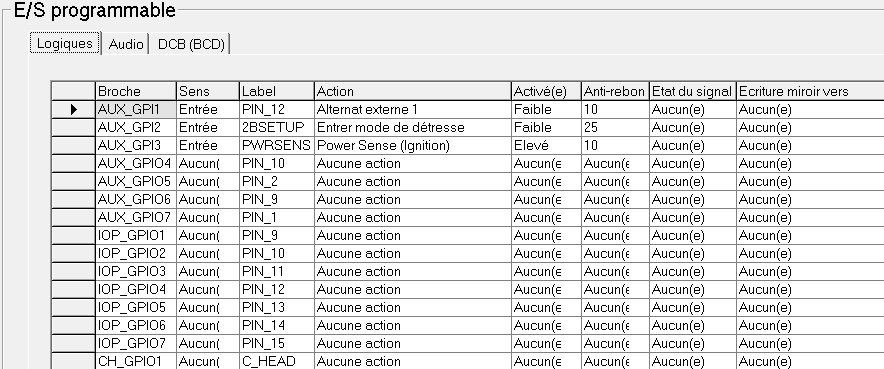
On the Audio tab, you must set Rx (which is the audio signal received by the transceiver) to an audio output point on R2.
For the EPPT1 row (corresponding to transmitted signal), the input point must be set to T13.

Réglage des voies Audio entrée et sortie du poste TAIT® TM8100
Here are the locations of the R2 and T13 points highlighted in the audio diagram.
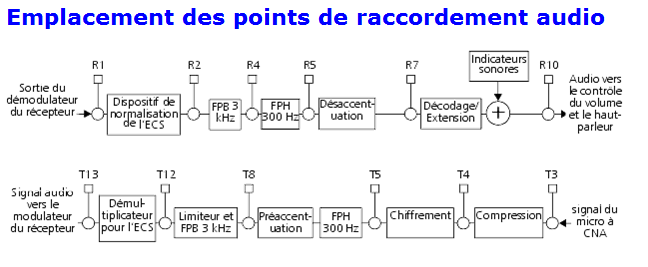
 : Audio connection poin (Output point or Audio input point)
: Audio connection poin (Output point or Audio input point)
ECS : peak excursion
FPB : low-pass filter
FPH : high-pass filter
CNA : automatic level control
Load both receiver and transmitter TAIT® TM8100 with the same configuration.
For those who might be interested, here is the Tait codeplug that I used for this tutorial : TM8110 Codeplug MMDVM DMR
MMDVM Tuning for DMR mode
The two transceivers are now configured and connected to the MMDVM board. We will realize the MMDVM setting using the MMDVMCal software. This part is developed more precisely in my article Install MMDVMHost on Raspberry Pi and tuning MMDVM for DMR digital mode
For the adjustment of the DMR emission, the potentiometer must be set to a high limit stop and thus passing so that the entire LF signal is transmitted to the transmitter without loss.
Run MMDVMCal
sudo /opt/MMDCal/MMDVMCal /dev/ttyACM0
Go to DMR deviation mode, by pressing D key (D uppercase).
Transmit (space bar) and control the transmisting spectrum. In my case, I use an SDR key to display the dynamic spectrum. Decrease the modulation amplitude until the central line disappears. I expect in my case 29%.
Exit the software with the Q key
Setting MMDVM.ini
It remains for us to configure the file MMDVM.ini
sudo nano /opt/MMDVMHost/MMDVM.ini
In the Modem section, we need to change these parameters for Tait® TM8100:
- TxInvert and RXInvert are set to 1
- DMRDelay is fixed to 90
- TXLevel is set to 27 (29% finded reduced by 5% – 29 x 0.95 ≅ 27 )
[Modem] Port=/dev/ttyACM0 #Port=\\.\COM3 TXInvert=1 RXInvert=1 PTTInvert=0 TXDelay=100 DMRDelay=90 RXLevel=85 TXLevel=27
Conclusion
We start MMDVMHost …
sudo /opt/MMDVMHost/MMDVMHost /opt/MMDVMHost/MMDVM.ini
Here is your MMDVM repeater ready to operate with TAIT® transceivers of the TM8100 series. This configuration may well be suitable for other series of the TAIT® brand. Do not hesitate to share your experiences by submitting your comments at the bottom of the page. This can interest other Sysop …
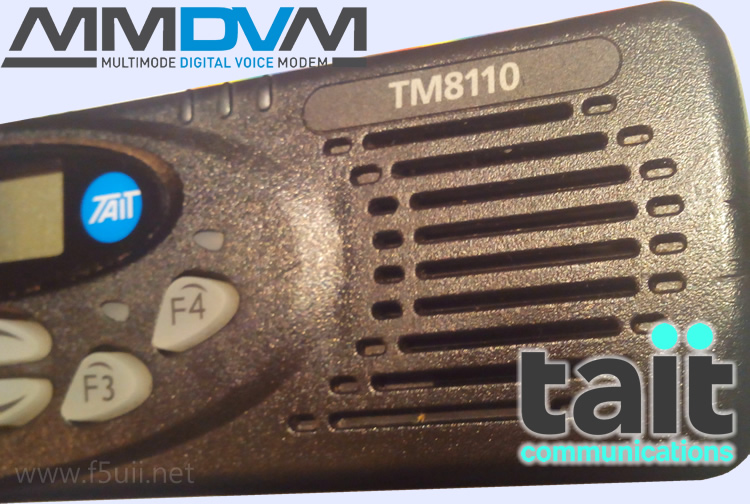

20KHz ? This is wrong bandwith. Use 12.5KHz for best results. i used TM8110 for two years on mmdvm with best results.
best config ;
(Traduction) 20 kHz ? Ceci est la mauvaise bande passante. 12,5kHZ donne les meilleurs résultats. J’utilise TM8110 depuis deux ans avec mmdvm avec de très bon résultats. La bonne config :
[Modem]
Port=/dev/ttyACM0
TXInvert=1
RXInvert=1
PTTInvert=0
TXDelay=100
DMRDelay=86
RXLevel=100
TXLevel=32
# CWIdTXLevel=50
# D-StarTXLevel=50
# DMRTXLevel=50
#YSFTXLevel=85
#P25TXLevel=80
RSSIMappingFile=RSSI.dat
Trace=0
SamplesDir=.
Debug=0
use direct TX path ( no TX pot).
RX level always at 100, use RX V divider to set input, besides RX pot.
(Traduction)
J’utilise la voie TX directement (sans potentiomètre TX)
Le niveau RX est toujours à 100, j’utilise un diviseur de tension pour RX, au cotté du potentiomètre de réglage RX.
Hello Adrian,
Thank you for your comments.
I have not note any evolution of quality in function of bandwith reception (12.5 or 20 kHz). Otherwise, i think there is no interest to disassemble the TX pot because tuning it to stop position is enough. On my side, i had no need to limit the audio level transmiting by the TM8110, so no voltage divider here. It is yes necessary for the motorola transceivers. This is precisely one of the functions provided by my Motorola accessory plug adapter.
(Traduction)
Bonjour Adrian,
Merci pour vos commentaires,
J’ai noté aucune évolution de qualité en fonction de la largeur de bande de réception (12.5 ou 20 kHz). Par ailleurs, je ne pense pas qu’il soit intéressant de démonter le potentiomètre de réglage de l’émission puisque le régler en buté est suffisant. De mon côté, je n’ai pas eu besoin de limiter le niveau audio transmit par le TM8110, donc pas de diviseur de tension. C’est par contre nécessaire pour les motorola. C’est justement une des fonctions apportés par ma platine adaptateur de prise accessoire Motorola.
Did you test in all 4 modes incl P25 ?
(Traduction)
Avez-vous essayer dans les 4 modes, incluant P25 ?
No, I have not tested the configuration with other mode than DMR.
(Traduction)
Non, je n’ai pas testé la configuration avec d’autres mdoes que le DMR.
That speaks for itself, For c4fm modes RX level must be lower than just for DMR, than standard SP8NTH rx pot minimum, especially with your bad rx opamp feedback R > 100K is too much gain #.
MMDVM.ini RXLevel must be 100% for best adc intercept point. Also your circuit design # has too much gain on RX opamp. Change 100K R to 30K R and see the difference, and better audio quality.
Extra inline rx audio in > R (10K) or v divider needed for good c4fm/P25 results and all modes.
In RX and TX > level is not everything. Gain and impedance match for a better signal pattern / form, regardless of level determine the audio quality both ways.
Hi There,
I have been working on my TM8110 simplex gateway for a while now and cannot get the TX to work a signal that can be decoded. I am wired into the 15-pin at the back of the radio and the signal seems to be weak. I have used your recommended settings, and I have went through DMRTXLevels from 100 -> 30 with TX invert to 0 & 1.
You mentions “use direct TX path”. Please can you advise where this is?
Regards,
Dave (EI5IMB).
(Traduction)
Bonjour,
Je travaille sur ma passerelle TM8110 simplex depuis un moment maintenant et je n’arrive pas à faire fonctionner le TX avec un signal qui peut être décodé. Je suis câblé dans le 15-pin à l’arrière de la radio et le signal semble être faible. J’ai utilisé vos paramètres recommandés, et j’ai parcouru les DMRTXLevels de 100 -> 30 avec l’inversion TX à 0 & 1.
Vous mentionnez “utiliser un câble direct au signal TX”. Pouvez-vous me dire où cela se trouve ?
Merci,
Dave (EI5IMB).
Also you are using 100K at minimum TX path. This is not enough. 200K TX pot or even better > direct TX path is required. Please provide a video of TX audio test on all 4 modes, and i will do the same to compare & prove to you which TX audio quality is superior? I have used all combinations of bandwidth, and deviation control, and over two years experience with the TM8110<>mmdvm, know which works best, having tried what you are doing now a long time ago, and have found much better since. Please test all 4 modes and see how your setting’s work then ?
You said ;
“On my side, i had no need to limit the audio level transmiting by the TM8110, so no voltage divider here.”
The V divider is for RX audio level control, not “transmitting”
The 12.5KHz benefit is obvious when you test RX range, isolation selectivity and signal quality properly.
I challenge you to test your audio quality in all 4 modes incl P25 against my system ?
Hi
I want use Tait TM8100 as a repeater can you help me about building cable between two radio???
I don’t know about pin out serial cable
hamednm66.gmail.com
(Traduction)
Bonjour
Je souhaite utiliser le Tait TM8100 comme répéteur. Pouvez-vous m’aider à construire le câble entre les deux radios ?
Je ne connais pas le brochage du câble série.
hamednm66.gmail.com
Très bonne configuration,
Ca apportera bien de l’aide aux OM’s.
73
F4GIX
(Translation)
Very good configuration,
It will bring a lot of help to OM’s.
73
F4GIX
I am building dmr using your mmdvm shield based on nucleo. But after testing with my old mobile radios I ended up changing them with something tested. I found Tait TM8115 really on deal. But now I have strugles with programming and do further testing. Is the Tait have programming key combination to be changed for programming?
And what version of the software did you use, and could you send it for a test? Also what cabe did you use, homebrew or stock cable?
Regards
73s
LZ1MOB
(Traduction)
Je construis un relais DMR en utilisant votre platine mmdvm à base de nucleo. Mais après avoir testé avec mes vieilles radios mobiles, j’ai fini par les changer avec quelque chose de testé. J’ai trouvé un Tait TM8115 d’occasion. Mais maintenant, j’ai des difficultés avec la programmation. Est-ce que la combinaison de touches de programmation du Tait doit être réalisé pour pouvoir réaliser la programmation?
Et quelle version du logiciel avez-vous utilisée, et pourriez-vous l’envoyer pour un test? De plus, quel câble avez-vous utilisé, homebrew ou câble standard?
Salutations,
73s
LZ1MOB
I didn’t try to make a serial cable, but I bought a USB cable directly for Tait ()
All programming is performed by a specific Tait software. You need the correct version of the software that depends on the firmware of the device. For my part, I used TM8200_Tx9300_PROG_v2.12.1.3. exe which corresponds to my device. It is often the most complicated: having the compatible software of the workstation.
(Traduction)
Je n’ai pas cherché à fabriquer un câble série, mais j’ai directement acheter un câble USB pour Tait (Par exemple sur ebay)
Toute la programmation se réalise par un logiciel spécifique Tait. Il faut la bonne version du logiciel qui dépend du firmware du poste. Pour ma part, j’ai utilisé TM8200_Tx9300_PROG_v2.12.1.3.exe qui correspond aux postes. C’est souvent le plus compliqué : avoir le logiciel compatible du poste.
Hi, thanks for the great post. Please could you tell me which manual you found the tap points in the audio chain, so I find the English version?
Thanks
(Traduction)
Bonjour, merci pour le super post. Pouvez-vous me dire quel manuel vous avez trouvé dans la chaîne audio, pour que je trouve la version anglaise?
Merci
Matthew,
The diagrams are extracted of the Motorola CPS software online help (F1).
Les schémas sont extraient de la documentation incluse dans le logiciel CPS de Motorola (touche F1)
73
Hi,
Thanks for this informative post.
I am thinking of trying this with the TM-8105 data radio (because it is the cheapest 25w option for me), but I think I might need some advice with the Tx calibration step as I have not used an SDR before. Can you advise me on a cheap SDR device and the software you used to get the baseband plot during the Tx tuning phase?
I’d like to do this properly : )
Gary,
M6UDS
(Traduction)
Salut,
Merci pour cet article informatif.
Je pense l’essayer avec la radio TM-8105 (parce que c’est l’option 25w la moins chère pour moi), mais je pense que j’aurai peut-être besoin de conseils avec l’étape d’étalonnage Tx car je n’ai jamais utilisé un SDR auparavant. Pouvez-vous me conseiller sur un appareil SDR bon marché et le logiciel que vous avez utilisé pour obtenir le tracé de bande de base pendant la phase de réglage de Tx ?
J’aimerais le faire correctement : )
Gary,
M6UDS
Thank you Gary,
The simplest and cheapest is to use a USB key of reception television TNT with processor RTL2832, R820T2 or equivalent. This costs around 10 USD.
Here is the english guide : https://www.rtl-sdr.com/rtl-sdr-quick-start-guide/
For calibration tuning, you have to zoom over the TX frequency to see spectrum decomposition.
Good settings
Chris
(Traduction)
Merci Gary,
Le plus simple et le moins cher est d’utiliser une clé USB de réception télévision TNT avec processeur RTL2832, R820T2 ou équivalent. Cela coûte autour de 10EUR.
Voici le guide en anglais : https://www.rtl-sdr.com/rtl-sdr-quick-start-guide/, ou en français ici : https://www.passion-radio.org/blog/sdr-sharp-dongle-rtl2832-r820t-e4000/76466
Pour l’étalonnage, vous devez zoomer sur la fréquence TX pour voir la décomposition du spectre.
Bons réglages
Chris
Dear friend. I have read your article. MMDVM DMR Mode setup with Tait TM8100 transceiver, thank you very much for it. I have a Tait TM8115 transceiver and I would like to collect a DMR repeater for our region, but unfortunately I do not have a cable for the programmer and software security. Could you help in resolving this issue.
Thanks
UR5SPM Maks
(Traduction)
Cher ami. J’ai lu votre article. MMDVM DMR avec l’émetteur-récepteur Tait TM8100, merci beaucoup pour cela. J’ai un émetteur-récepteur Tait TM8115 et j’aimerais monter un répéteur DMR pour notre région, mais malheureusement je n’ai pas de câble pour le programmateur et la sécurité logicielle. Pourriez-vous nous aider à résoudre ce problème ?
Merci
UR5SPM Maks
Hello Maks,
Version 3.08.00.0002 of the tait software is freely available here :
http://www.radioswap.co.uk/content/userfiles/rss/tm8100V308.zip
In the Tools->Options it has the following languages :
(English, Chinese Simplified, French, Spanish)
Radioswap is an authorised Tait vendor in the UK.
I hope this helps
Gary
(Traduction)
Bonjour Maks,
La version 3.08.00.00.0002 du logiciel tait est disponible gratuitement ici :
http://www.radioswap.co.uk/content/userfiles/rss/tm8100V308.zip
Dans le menu Outils->Options, il y a les langues suivantes :
(anglais, chinois simplifié, français, espagnol)
Radioswap est un vendeur autorisé de Tait au Royaume-Uni.
J’espère que cela vous aidera
Gary
Maks,
I add that for cable, for facilities, I bought online this cable. It plugs in instead of the microphone
Thanks also to Gary for its contribution
(Traduction)
J’ajoute que pour le cable, pour des facilités, j’avais acheté un câble en ligne. Il se branche à la place du microphone
Merci également à Gary pour sa contribution
Thank you very much for your help. Very useful information. Thanks to your help, I was able to program my stations, now I’m working on creating a DMR repeater for your instructions
(Traduction)
Merci beaucoup pour votre aide. Informations très utiles. Grâce à votre aide, j’ai pu programmer mes stations, maintenant je travaille sur la création d’un relais DMR pour votre information.
Maks
Thank you for your support. Good progress and success in the construction of your DMR repeater.
73
(Traduction)
Maks
Merci pour votre soutien. Bonne continuation et succès dans la réalisation de votre relais DMR.
73
Hi Chris,
I was wondering if it would be possible to obtain a code plug for the TM8100 series radio? I am having an issue connecting the STM32 V2 board with two UHF Tait radios and I suspect it may be with the radio configuration in particular with the AUX pins assignments. A simple code plug would be perfect that I can edit to substitute frequencies, etc.
Any help would be appreciated Chris,
Many thanks,
73,
Brian EI8EJB
(Traduction)
Salut Chris,
Je me demandais s'il serait possible d'obtenir le codeplug pour la radio de la série TM8100 ? J'ai un problème de connexion de la carte STM32 V2 avec deux radios UHF Tait et je soupçonne que cela peut être dû à la configuration radio, en particulier à l'affectation des broches AUX. Une codeplug simple serait parfait pour que je puisse éditer pour substituer des fréquences, etc.
Toute aide serait appréciée Christian,
Merci beaucoup.
73,
Brian EI8EJB
Hi Brian,
I just added my TM8110 codeplug in the above article.(https://www.f5uii.net/en/tuning-mmdvm-dmr-tait-tm8100-tm8115/#linkcdp) Hoping that will help you for completing your MMDVM repeater.
73
Chris
(Traduction)
Je viens d'ajouter mon codeplug TM8110 dans l'article ci-dessus.(https://www.f5uii.net/tuning-mmdvm-dmr-tait-tm8100-tm8115/#linkcdp) En espérant que cela vous aidera à compléter votre répéteur MMDVM.
73
Chris
Hi Chris,
WOW! That was very kind of you to respond so quickly to my query! Many thanks to you and continued success with all your wonderful projects. I look forward to programming the radios with a modified version of your code plug Chris.
Merci beaucoup,
Best 73,
Brian EI8EJB
(Traduction)
Bonjour Chris,
WOW ! C'est très aimable à vous d'avoir répondu si vite à ma question ! Un grand merci à vous et un succès continu avec tous vos merveilleux projets. J'ai hâte de programmer les radios avec une version modifiée de votre codeplug, Chris.
Merci beaucoup. Meilleurs 73,
Brian EI8EJB
Hallo Christian
I have two Vertex VX-2100 Series radios. I was planning to connect the 2 radios to the MMDVM DMR Mode. Can you please have a look at the spec and give your opinion to connect the radios to DMR?
The radio have a D-Sub 15-Pin Accessory Connector
External TX audio line input, PTT (Push To Talk), Squelch, and external RX
audio line output signals may be obtained from this connector for use with accessories such as data transmission/reception modems, and external Channel control input etc.
Regards
Lappies
ZS6RL
(Traduction)
Bonjour Christian
J’ai deux radios de la série Vertex VX-2100. J’avais l’intention de connecter les 2 radios au mode DMR du MMDVM. Pouvez-vous s’il vous plaît jeter un coup d’oeil aux spécifications et donner votre opinion pour connecter les radios en DMR ?
La radio est équipée d’un connecteur d’accessoires Sub-D à 15 broches.
Entrée ligne audio TX externe, PTT (Push To Talk), Squelch et réception RX
Les signaux de sortie de ligne audio peuvent être obtenus à partir de ce connecteur pour une utilisation avec des accessoires tels que les modems de transmission/réception de données, l’entrée de contrôle de canal externe, etc.
Salutations
Lappies
ZS6RL
Hello,
I read the service Manual of VX-2100 (Here is a link from wwgradio.com).
Usually it is found that the equipment can transmit at 9600 bauds, if this is the case, this leads to the conclusion that the station could be compatible. This will only be confirmed with an MMDVM assembly and adjustment.
In addition, I have not found any online publications that show that the VX-2100 was used with MMDVM.
On this page only the VX-9000 model is indicated as compatible. But this equipment is by far not of the same generation as the 2100.
Regards
(Traduction)
Bonjour,
J’ai lu le manuel de service du VX-2100 (Voici un lien depuis wwgradio.com).
Habituellement, on constate que l’équipement peut transmettre à 9600 bauds, si c’est le cas, cela conduit à la conclusion que la station pourrait être compatible. Ceci ne sera confirmé qu’avec un montage et un réglage MMDVM.
De plus, je n’ai trouvé aucune publication en ligne qui montre que le VX-2100 a été utilisé avec le MMDVM.
Sur cette page seul le modèle VX-9000 est indiqué comme compatible. Mais cet équipement n’est de loin pas de la même génération que le 2100.
Salutations
Hi
Is it possible to get the schematics for the interface cable, I have problem connecting and i dont want to damage my radios.
Regards Thorbjörn
SM7YTN
(Traduction)
Salut
Est-il possible d’obtenir les schémas du câble d’interface, j’ai des problèmes de connexion et je ne veux pas endommager mes radios.
Salue Thorbjörn
SM7YTN
The pins to be used on the Tait side are clear. It depends on your configuration. When using two phones (one transmitter, one receiver), you connect the TX only to the TX connector on your MMDVM board, and for the second phone, you connect the RX to the RXd connector on your MMDVM board.
Here you will find the schematic of the MMDVM based on STM32
(Traduction)
Les broches à utiliser coté Tait sont clair . Cela dépend de votre configuration. En utilisant deux postes(un émetteur, un récepteur), vous raccorder ce qui est TX uniquement vers le connecteur TX de votre platine MMDVM, et pour le second poste, vous raccorder ce qui est RX vers le connecteur RXd de votre platine MMDVM.
Ici vous trouvez le plan du MMDVM à base de STM32
Hi
This is BI4SQM and I’m try to connect a handheld such as a Baofeng UV5R to the MMDVM board, but I heard infos that the MMDVM board does not supports handheld, need to use a mobile radio such as the motorolas, I’m curiously does this comment correct? And why? Thanks.
(Traduction)
Bonjour
C’est BI4SQM et j’essaye de connecter un portable tel qu’un Baofeng UV5R à la carte MMDVM, mais j’ai entendu des infos comme quoi la carte MMDVM ne supporte pas les portables, il faut utiliser une radio mobile telle que les motorolas, je suis curieux de savoir si cette affirmation est exacte ? Et pourquoi ? Merci.
Yes, the transmitting and receiving radio equipment must be capable of transmitting the FSK signal at a speed of 9600 bauds. A bandwidth of 15 kHz is required in FM. Here is a list of tested compatible or half-compatible equipment with MMDVM. And obviously the UV5R is not part of it, it should not be surprising…
(Traduction)
Oui il faut que les équipements radio émission et réception soient capable de faire transiter le signal FSK transitant à la vitesse de 9600 bauds. Un largeur de bande de 15 kHz est nécessaire en FM. Voici une liste d’équipements testés compatible ou à moitié compatible avec MMDVM. Et évidemment l’UV5R n’en fait pas partie, il ne faut pas s’en étonner…
Bonjour,
je voulais brancher un micro et un bouton de détresse sur une Tait TM9300 sur la prise accessoire SUBD15 est ce que c’est possible.et si vous avez un schéma je serais reconnaissant.
Cordialement.
(Translation)
Hello,
I wanted to connect a microphone and a distress button on a Tait TM9300 on the SUBD15 accessory socket. Is this possible and if you have a diagram I would be grateful.
Yours faithfully
Bonjour,
Vous allez trouver toutes les informations nécessaire dans les paragraphes 4.9 et 3.1 du guide d’installation du TAIT TM9300 / TM9400 P25.
(Translation)
Hello,
You will find all the information you need in paragraph 4.9 & 3.1 of the TAIT TM9300 / TM9400 P25 installation guide.
Hello, I would like to ask you wiring diagram between MMDVM modem and Tait TM8115. Can you help me?
Thank you
73 de 4L2IK
(Traduction)
Bonjour, je voudrais vous demander le schéma de câblage entre le modem MMDVM et le Tait TM8115. Pouvez-vous m’aider ?
Je vous remercie de votre aide.
73 de 4L2IK
J’utilise deux TAIT TM8100 pour le relais F5ZZD.
J’ai configuré un code CTCSS dans les champs SigRX et SigTX avec une fréquence de 82,5 Hz et une bande passante de 12,5 kHz.
Le problème est qu’une radio émettrice sans code CTCSS déclenche le squelch et active le PTT. Je n’arrive pas à identifier la cause de ce problème.
Quelqu’un pourrait-il m’aider ?
(Translation)
I am using two TAIT TM8100 radios for the F5ZZD repeater. I have configured a CTCSS code in the SigRX and SigTX fields with a frequency of 82.5 Hz and a bandwidth of 12.5 kHz. The problem is that a transmitting radio without a CTCSS code triggers the squelch and activates the PTT. I can’t identify the cause of this problem. Could someone help me?
Cela dépend de l’usage recherché. Il existe plusieurs paramètres traitant du CTCSS.
SQL_DET, SQL_COMBINE, TONE, OPEN_ON_CTCSS, CTCSS_MODE, CTCSS_*,
Je vous invite à étudier le manuel SVXLINK pour clarifier cela.
(Translation)
This depends on the intended use. There are several parameters dealing with CTCSS, such as SQL_DET, SQL_COMBINE, TONE, OPEN_ON_CTCSS, CTCSS_MODE, CTCSS_*, etc. I invite you to study the SVXLINK manual to clarify this.